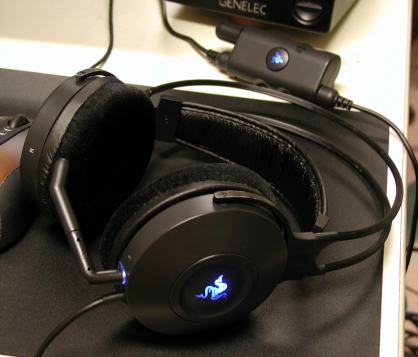The Amazing 5.almost-1 Razer Barracuda Headphones
While searching for the ultimate gaming keyboard[*]
I came across the Razer Barracuda headphones. As frequent late-night gamer, I was immediately attracted, and bought a pair. The features speak for themselves:
- 5.1 surround
- Microphone
- Amplification
- Bling
Excellent, these can help to achieve two goals: 1) an immersive experience, and 2) better positional location of enemies. I didn’t notice the bling factor until I got them home and plugged them in.
Uh oh, blinky lights. Expensive, blue blinky lights. Let’s hope they didn’t spend their entire budget on those lights. There is also a switch to turn off the lights. This is a good thing, because when I went to bed they were lighting up half the room. (The computer turns off, but the light stays on!)
There are a million plugs (well, four) and a USB connector on the end. The USB powers the six-channel amplifier. The amplifier has volume controls for each channel, and this is a good thing (see below). So, I plugged all of these into my NVidia integrated sound card (which is basically a Realtek chip) and so on. The surround sound works pretty well, but not perfectly. Since the front and rear speakers can’t really be in front of or behind you, there is a limitation to how far the audio image can seem to rotate. Also, the rear speakers are tiny, tinny speakers. This is probably OK, because it’s like a free audible clue that something is actually behind you (since the spatial positioning is a bit limited anyway).
In terms of sound quality, they’re quite musical and reasonably flat. I didn’t do a/b comparisons with monitoring headphones, because these are gaming phones. For gaming they are quite good, sound quality-wise. Quite good, but with one exception. They have no bass. Well, this isn’t strictly true. But it’s very quiet. I turned all of the other channels off, and checked my crossover, and bass was definitely happening. Just not very much, that’s all.
An article in Razer’s knowledge base suggests turning down the volume of all channels but the subwoofer channel. This works…if you like your games really really quiet. In addition, the subwoofer speakers go “booong” when I thump the side of the phones. It sounds, well, like the low tom on a drum set. And, yes, this resonance, once I noticed it, was audible any time a bass impact happens in a game.
The subwoofer is unacceptably weak for a pair of gaming headphones. Considering that they have their own special amplifier, this is very odd! I boosted the bass and maximized every volume control, and managed to get them almost loud enough. Almost doesn’t cut it, though! So, I satisfied my need for bass using the Buttkicker Gamer, and found them to be very comfortable for extended gaming sessions, both physically and aurally. But I still feel like I paid for a subwoofer that doesn’t work.
Wait, what about the microphone? Well, it works OK. Since it only reaches halfway to your mouth, it tends to pick up a lot of background noise, and I had to crank the mic gain and enable boost. Slightly sub par, but it looks cool.
In the final analysis, are they better than using a nice Audigy sound card and regular headphones? It seems about the same to me. I think that you’ll get better sound from a $79 pair of audiophile headphones[**], and just use the “headphones” setting on your sound card. I’m using a really, truly ancient pair of AKGs now. Anybody want to buy a pair of surround sound headphones with really bitchin blue lights?
* – which is to say, one that feels like I remember Mac SE keyboards feeling, but for real, and not just in my imagination
** – Well, you can’t really get an “audiophile” pair of phones for 80 bucks, but you can get some really nice ones!


